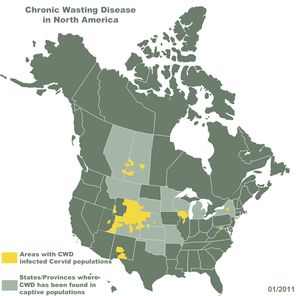Chronic wasting disease still a threat to big game
HUNTING -- Chronic wasting disease isn't getting the press it received a decade ago as the malady was being documented in deer and elk in several states and provinces. However, while stepped up testing programs from coast to coast are affirming that most areas remain disease free, CWD is still cropping up in new places, according to the Chronic Wasting Disease Alliance.
For example, in testing done during the past hunting season:
- MaryIand documented its first case of CWD in a deer.
- Minnesota documented the first case in a deer outside of the fenced captive herd where CWD was documented in 2002.
- Alberta tested 12 new cases in wild deer among more than 3,000 heads tested.
- Nebraska found CWD in a record 52 of 3,645 deer tested, but found only a slight increase in the area where previous CWD cases had been detected.
- South and North Dakota found 3 cases among 243 elk samples and 22 among 1,407 deer.
Washington and Idaho remain free of CWD.
CWD is a disease of the central nervous system in deer and elk that’s related to the "mad cow" disease that affects cattle. To date, there’s been no link between CWD and diseases that affect humans.
Wildlife officials throughout the country advise hunters to avoid eating the meat of any animal that shows symptoms of being anything less than 100 percent healthy. However, it's notable that the some of the states reporting deer testing positive to the disease also noted that the deer were otherwise healthy, according to the CWD Alliance's latest report.
Read on for more info on how CWD is affecting hunters.
Chronic wasting disease is having an impact on Inland Northwest hunters even though ongoing testing has never documented the disease in wild deer or elk from Idaho or Washington.
The Washington Fish and Wildlife Commission has adopted restrictions on importation of bone-in deer and elk carcasses or body parts harvested in states where CWD has been documented:, including Colorado, Wyoming, Utah, New Mexico, Wisconsin, Illinois, South Dakota, Nebraska and the province of Saskatchewan.
The bone-in carcass restriction was prompted by research studies in Colorado and Wyoming which showed disease can be spread from the decomposing carcasses of infected animals.
Testing for CWD is being conducted in at least 47 states, including Washington and Idaho.
At least 17 states and one Canadian province have put restrictions on the importation of hunter-harvested deer and elk. Those states include California, Colorado, Illinois, Iowa, Kentucky, Michigan, Montana, Minnesota, North Dakota, New Mexico, New York, Oregon, Rhode Island, South Carolina, Utah, Vermont and Washington as well as Manitoba.
At least nine states prohibit the feeding of deer and elk and several other states are discussing a ban on feeding to help prevent the spread of various diseases that can be spread among big-game animals when they are concentrated.
Such legislation introduced in the Washington Legislature has not been approved.
Minnesota sees it differently.
In an effort to keep the disease from spreading, Minnesota has liberalized hunting to reduce the number of deer in the area where the disease has been detected and made it illegal to feed deer in four counties to prevent concentrating deer.

